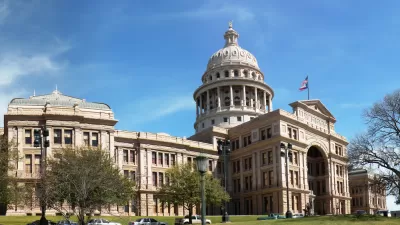Following-up on the depavement of 83 miles of "farm-to-market" roads, TxDOT now proposes a much larger budget-saving measure: "Turn back" control of 2,000 miles of these state roadways to counties and cities. TxDOT also wants to focus on urban roads.
Gail Delaughter explains the two major reasons for what is being called the "turnback" proposal. She also broadcasts her story on an accompanying 2:32 audio tape.
- Budgetary: Texas Department of Transportation (TxDOT) had requested "about $4 billion for future transportation needs" during the legislative sessions. As we posted here on August 12, a measure did pass to allow voters to decide next year "whether or not to divert about $1.2 billion of oil and gas revenues from the state’s Rainy Day Fund to the state's highway fund". Lacking sufficient revenue to maintain all of its 80,000 roads, the aim is to reduce the road burden by letting "local governments start footing the bill for things like resurfacing and pothole repair", Delaughter writes.
- Urban Focus: Delaughter reports that Texas Transportation Commissioner Jeff Moseley "says the money that now goes to local road maintenance could be better used for other projects, like increasing capacity on the state's congested freeways."
"We have 1,200 new Texans every day moving into our state. Many of these families are bringing two automobiles, and about 85% of those are coming into the urban areas of Texas, including Houston."
The five-member Texas Transportation Commission oversees statewide activities of TxDOT. It would seem that in addition to rural vs. urban, the choice the commission is considering is one of congestion mitigation over maintenance - a choice we questioned here last year.
Texas roads crisis Part 1 dealt with the proposal to convert 83 miles of farm-to-market, asphalt roads to gravel, partly in response to the significant toll that heavy trucks servicing the energy industry makes on these roads. No mention was made by Gail Delaughter of the road damage caused by these trucks, making it clear that that TxDOT's budgetary crisis goes beyond road damage caused by the state's booming energy industry.
These painful budgetary measures were forewarned by state Sen. Kevin Eltife (R-Tyler) when he proposed adding 10-cents to the 20-cent state gas tax, wrote Tom Benning of the Dallas Morning News on February 18.
Until we have the political courage to really find the robust, long-sustaining revenue, we’re going to damage to our state’s infrastructure and to this industry,” he said.
FULL STORY: Local Officials Concerned Over TxDOT Money-Saving Proposal

Planetizen Federal Action Tracker
A weekly monitor of how Trump’s orders and actions are impacting planners and planning in America.

Restaurant Patios Were a Pandemic Win — Why Were They so Hard to Keep?
Social distancing requirements and changes in travel patterns prompted cities to pilot new uses for street and sidewalk space. Then it got complicated.

Map: Where Senate Republicans Want to Sell Your Public Lands
For public land advocates, the Senate Republicans’ proposal to sell millions of acres of public land in the West is “the biggest fight of their careers.”

Maui's Vacation Rental Debate Turns Ugly
Verbal attacks, misinformation campaigns and fistfights plague a high-stakes debate to convert thousands of vacation rentals into long-term housing.

San Francisco Suspends Traffic Calming Amidst Record Deaths
Citing “a challenging fiscal landscape,” the city will cease the program on the heels of 42 traffic deaths, including 24 pedestrians.

California Homeless Arrests, Citations Spike After Ruling
An investigation reveals that anti-homeless actions increased up to 500% after Grants Pass v. Johnson — even in cities claiming no policy change.
Urban Design for Planners 1: Software Tools
This six-course series explores essential urban design concepts using open source software and equips planners with the tools they need to participate fully in the urban design process.
Planning for Universal Design
Learn the tools for implementing Universal Design in planning regulations.
Heyer Gruel & Associates PA
JM Goldson LLC
Custer County Colorado
City of Camden Redevelopment Agency
City of Astoria
Transportation Research & Education Center (TREC) at Portland State University
Camden Redevelopment Agency
City of Claremont
Municipality of Princeton (NJ)



























